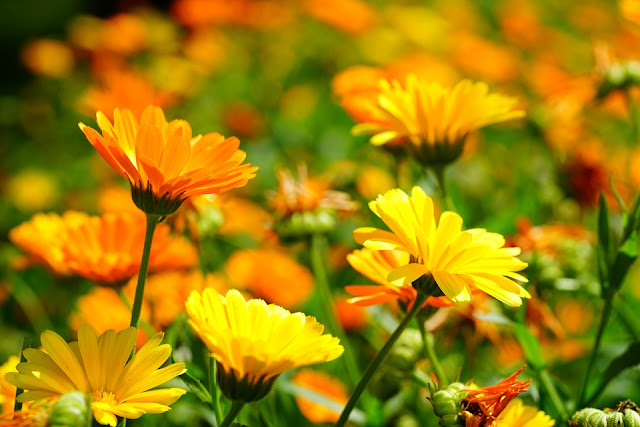Wild Herbs 101: Calendula (Facts, Recipes & History)
Pot Marigold - Calendula officinalis
Description: This cheerful, hardy plant is a long-blooming annual easily started from seed. All it requires are sunshine, soil, and occasional waterings to reward you with edible and medicinal flowers all growing season long! It is a potent, but gentle herb safe for skincare - even for babies! (2)
Other Names: pot marigold, ruddles, common marigold, Scotch marigold
Folklore: A 12th century herbal manuscript by Macer Floridus swore that simply looking at calendula could "improve eyesight, clear the head, and encourage cheerfulness". (3) While those promises seem a little fanciful, there may be some truth to them! The bright orange and yellow blossoms are pleasant to look at and the plants themselves contain carotenoids, including beta carotene. So calendula may indeed be good for the eyes!
Biological Properties: Calendula contains compounds that are anti-inflammatory, anti-viral, anti-fungal and anti-microbial. (4) Also 19 different carotenoids were found in pot marigold petals! All of its amazing properties make it perfect for soothing, feeding, and balancing skin.
Usage: As a tincture, salve, face mask, face wash or cream from the petals. Harvest the blooms, wash, and use fresh (for gentleness) or dry (for potency). The Herbal Academy has an excellent video & recipe guide for how to make your very own Calendula salve. They also have a post with 14 different recipes and ways to use this bright, beneficial little flower. The leaves can be used as a poultice for scratches and skin irritation to speed up healing.
Warnings: None. Using pot marigold petals as ingredients in DIY skincare or as garnish for salads is wonderful and very safe. Do your own thorough research before attempting to use the leaves, stalks or roots of Calendula. As always, do a patch skin test with your homemade skin care products before using regularly!
Where to Find It: If you don't have access to backyard Calendula plants, you can buy seeds, buy the plants at your local plant nursery, purchase safe products made with Calendula, or buy it in bulk online. I recommend the natural beauty Weleda brand for excellent, gentle Calendula face creams.
As with any herb, moderation and smart usage is key. Try a Calendula salve. Sprinkle some petals on your salads. Watch the flowers attract many pollinators to your garden. Enjoy the delicious, colorful health benefits of this cheerful flower!
Herbal Blessings,
Where to Find It: If you don't have access to backyard Calendula plants, you can buy seeds, buy the plants at your local plant nursery, purchase safe products made with Calendula, or buy it in bulk online. I recommend the natural beauty Weleda brand for excellent, gentle Calendula face creams.
As with any herb, moderation and smart usage is key. Try a Calendula salve. Sprinkle some petals on your salads. Watch the flowers attract many pollinators to your garden. Enjoy the delicious, colorful health benefits of this cheerful flower!
Herbal Blessings,
References
(1) Shorter Oxford English Dictionary
(2)Rosemary Gladstar's Medicinal Herbs: A Beginner's Guide
(3) The Complete Medicinal Herbal, by Penelope Ody
(4) Practical Herbalism, by Philip Fritchey, MH, ND, CNHP
(2)Rosemary Gladstar's Medicinal Herbs: A Beginner's Guide
(3) The Complete Medicinal Herbal, by Penelope Ody
(4) Practical Herbalism, by Philip Fritchey, MH, ND, CNHP








Comments
Post a Comment